Wave and Meso-Scale Eddy Climate in the Arctic Ocean
Abstract
1. Introduction
2. Materials and Methods
2.1. Model Settings of WW3
2.2. Fields for Modeling Waves
2.3. Altimeter-Based Data
2.4. Meso-Scale Eddy Identification
- (1)
- The components of the current speed u and v on both sides of the eddy center have opposite signs, and their absolute value increases with movement away from the center.
- (2)
- The minimum velocity point within the selected range is defined as the indeterminacy eddy center.
- (3)
- The directions of the two adjacent velocity vectors around the eddy center have to be close to each other and located in the same or adjacent quadrants to ensure the same direction of rotation.
3. Results and Discussions
3.1. Wave Distribution
3.2. Variation in Meso-Scale Eddies
3.3. Discussions
4. Conclusions
Author Contributions
Funding
Institutional Review Board Statement
Informed Consent Statement
Data Availability Statement
Acknowledgments
Conflicts of Interest
References
- Proshutinsky, A.; Pavlov, V.; Bourke, R.H. Sea level rise in the Arctic Ocean. Geophys. Res. Lett. 2001, 28, 2237–2240. [Google Scholar] [CrossRef]
- Liu, Q.X.; Alexander, V.B.; Stefan, Z.; Young, L.R.; Guan, C.L. Wind and wave climate in the Arctic Ocean as observed by altimeters. J. Clim. 2016, 29, 7957–7975. [Google Scholar] [CrossRef]
- Stopa, J.E.; Fabrice, A.; Fanny, G.A. Wave climate in the Arctic 1992–2014: Seasonality and trends. Cryosphere 2016, 10, 1605–1629. [Google Scholar] [CrossRef]
- Rohling, E.J.; Grant, K.; Hemleben, C.; Siddall, M.; Hoogakker, B.; Bolshaw, M.; Kucera, M. High rates of sea-level rise during the last interglacial period. Nat. Geosci. 2008, 1, 38–42. [Google Scholar] [CrossRef]
- Shao, W.Z.; Yu, W.P.; Jiang, X.W.; Shi, J.; Wei, Y.L.; Ji, Q.Y. Analysis of wave distributions using the WAVEWATCH-III model in the Arctic Ocean. J. Ocean Univ. China 2022, 21, 15–21. [Google Scholar] [CrossRef]
- Shimada, K.; Kamoshida, T.; Itoh, M.; Nishino, S.; Carmack, E.; Mclaughlin, F.; Zimmermann, S.; Proshutinshy, A. Pacific Ocean inflow: Influence on catastrophic reduction of sea ice cover in the Arctic Ocean. Geophys. Res. Lett. 2016, 33, 153–172. [Google Scholar] [CrossRef]
- Perrie, W.; Toulany, B.; Roland, A.; Dutour-Sikiric, M.; Chen, C.S.; Beardsley, R.C.; Qi, J.H.; Hu, Y.C.; Casey, M.; Shen, H. Modeling north Atlantic Nor’easters with modern wave forecast models. J. Geophys. Res. 2018, 123, 533–557. [Google Scholar] [CrossRef]
- Shao, W.; Jiang, T.; Zhang, Y.; Shi, J.; Wang, W. Cyclonic wave simulations based on WAVEWATCH-III using a sea surface drag coefficient derived from CFOSAT SWIM data. Atmosphere 2021, 12, 1610. [Google Scholar] [CrossRef]
- Sheng, Y.X.; Shao, W.Z.; Li, S.Q.; Zhang, Y.M.; Yang, H.W.; Zuo, J.C. Evaluation of typhoon waves simulated by WaveWatch-III model in shallow waters around Zhoushan islands. J. Ocean Univ. China 2019, 18, 365–375. [Google Scholar] [CrossRef]
- Yang, Z.H.; Shao, W.Z.; Ding, Y.Y.; Shi, J.; Ji, Q.Y. Wave simulation by the SWAN model and FVCOM considering the sea-water level around the Zhoushan islands. J. Mar. Sci. Eng. 2020, 8, 783. [Google Scholar] [CrossRef]
- Chassignet, E.P.; Hulburt, H.E.; Smedstad, O.M.; Halliwell, G.R.; Hogan, P. The HYCOM (Hybrid Coordinate Ocean Model) data assimilative system. J. Mar. Syst. 2007, 65, 60–83. [Google Scholar] [CrossRef]
- Li, Q.; Wu, H.; Yang, H.; Zhang, Z. A numerical simulation of the generation and evolution of nonlinear internal waves across the Kara Strait. Acta Meteorol. Sin. 2019, 38, 5–13. [Google Scholar] [CrossRef]
- Tolman, H.L.; Chalikov, D.V. Source terms in a third-generation wind wave model. J. Phys. Oceanogr. 1996, 26, 2497–2518. [Google Scholar] [CrossRef]
- Zheng, K.W.; Osinowo, A.; Sun, J.; Hu, W. Long term characterization of sea conditions in the East China Sea using significant wave height and wind speed. J. Ocean Univ. China 2018, 17, 733–743. [Google Scholar] [CrossRef]
- Wang, Z.F.; Guo, Y.J.; Cui, J.N.; Dong, S.; Wu, K.J. Effect of the drag coefficient on a typhoon wave model. J. Oceanol. Limnol. 2019, 37, 1795–1840. [Google Scholar] [CrossRef]
- Sun, Z.F.; Shao, W.Z.; Yu, W.P.; Li, J. A Study of wave-induced effects on sea surface temperature simulations during typhoon events. J. Mar. Sci. Eng. 2021, 9, 622. [Google Scholar] [CrossRef]
- Hu, Y.Y.; Shao, W.Z.; Li, J.; Zhang, C.L.; Cheng, L.Q.; Ji, Q.Y. Short-term variations in water temperature of the Antarctic Surface Layer. J. Mar. Sci. Eng. 2022, 10, 287. [Google Scholar] [CrossRef]
- Holthuijsen, L. The Continued Development of the Third-Generation Shallow Water Wave Model ‘SWAN’; Tu Delft Department of Hydraulic Engineering: Delft, The Netherlands, 2001; Volume 32, pp. 185–186. [Google Scholar]
- Rogers, W.E.; Hwang, P.A.; Wang, D.W. Investigation of wave growth and decay in the SWAN model: Three regional-scale applications. J. Phys. Oceanogr. 2010, 33, 366–389. [Google Scholar] [CrossRef]
- Zheng, K.W.; Sun, J.; Guan, C.L.; Shao, W.Z. Analysis of the global swell and wind-sea energy distribution using WAVEWATCH III. Adv. Meteorol. 2016, 7, 8419580. [Google Scholar] [CrossRef]
- He, H.; Song, J.; Bai, Y.; Xu, Y.; Bi, F. Climate and extrema of ocean waves in the East China Sea. Sci. China Earth Sci. 2018, 7, 980–994. [Google Scholar] [CrossRef]
- Squire, V.A.; Dugan, J.P.; Wadhams, P.; Rottier, P.J.; Liu, A.K. Of ocean waves and sea ice. Annu. Rev. Fluid Mech. 1995, 27, 115–168. [Google Scholar] [CrossRef]
- Tolman, H.L. Treatment of unresolved islands and ice in wind wave models. Ocean Model. 2003, 5, 219–231. [Google Scholar] [CrossRef]
- Liu, A.K.; Holt, B.; Vachon, P.W. Wave propagation in the marginal ice zone: Model predictions and comparisons with buoy and synthetic aperture radar data. J. Geophys. Res. 1991, 96, 4605–4621. [Google Scholar] [CrossRef]
- De Carolis, G.; Desiderio, D. Dispersion and attenuation of gravity waves in ice: A two-layer viscous fluid model with experimental data validation. Phys. Lett. A 2002, 305, 399–412. [Google Scholar] [CrossRef]
- Kohout, A.L.; Meylan, M.H. An elastic plate model for wave attenuation and ice floe breaking in the marginal ice zone. J. Geophys. Res. 2008, 113, C09016. [Google Scholar] [CrossRef]
- Wang, R.; Shen, H.H. Gravity waves propagating into an icecovered ocean: A viscoelastic model. J. Geophys. Res. 2010, 115, C06024. [Google Scholar]
- Williams, T.D.; Bennetts, L.G.; Squire, A.V.; Dumont, D.; Bertino, L. Wave-ice interactions in the marginal ice zone. Part 1: Theoretical foundations. Ocean Model. 2013, 71, 81–91. [Google Scholar] [CrossRef]
- Li, J.K.; Ma, Y.R.; Liu, Q.X.; Zhang, W.Q.; Guan, C.L. Growth of wave height with retreating ice cover in the Arctic. Cold Reg. Sci. Technol. 2019, 164, 102790. [Google Scholar] [CrossRef]
- Li, J.K.; Kohout, A.L.; Shen, H.H. Comparison of wave propagation through ice covers in clam and storm conditions. Geophys. Res. Lett. 2015, 42, 5935–5941. [Google Scholar] [CrossRef]
- Stoffelen, A.; Verspeek, J.A.; Vogelzang, J.; Verhoef, A. The CMOD7 Geophysical Model Function for ASCAT and ERS Wind Retrievals. IEEE J. Sel. Top. Appl. Earth Observ. Remote Sens. 2017, 10, 2123–2134. [Google Scholar] [CrossRef]
- Shao, W.Z.; Jiang, T.; Jiang, X.W.; Zhang, Y.G.; Zhou, W. Evaluation of sea surface winds and waves retrieved from the Chinese HY-2B data. IEEE J. Sel. Topics Appl. Earth Observ. Remote Sens. 2021, 14, 9624–9635. [Google Scholar] [CrossRef]
- Shao, W.; Jiang, X.; Sun, Z.; Hu, Y.; Marino, A.; Zhang, Y. Evaluation of wave retrieval for Chinese Gaofen-3 synthetic aperture radar. Geo-Spat. Inf. Sci. 2022, 25, 229–243. [Google Scholar] [CrossRef]
- Xu, Y.; Liu, J.Q.; Xie, L.L.; Sun, C.R.; Liu, J.P.; Li, J.Y. China-France Oceanography Satellite (CFOSAT) simultaneously observes the typhoon-induced wind and wave fields. Acta Oceanol. Sin. 2019, 38, 158–161. [Google Scholar] [CrossRef]
- Fukumori, I.; Raghunath, R.; Fu, L.L.; Chao, Y. Assimilation of TOPEX/Poseidon altimeter data into a global ocean circulation model: How good are the results? J. Geophys. Res. 1999, 104, 25647–25665. [Google Scholar] [CrossRef]
- Dong, C.; Lin, X.; Yu, L.; Nencioli, F.; Yi, C.; Guan, Y.; Dickey, T.; McWilliams, J. Three-dimensional oceanic eddy analysis in the southern California bight from a numerical product. J. Geophys. Res. 2012, 117, C00H14. [Google Scholar] [CrossRef]
- Lin, X.; Dong, C.; Chen, D.; Yu, L.; Guan, Y. Three-dimensional properties of mesoscale eddies in the south China sea based on eddy-resolving model output. Deep-Sea Res. Pt. I 2015, 99, 46–64. [Google Scholar] [CrossRef]
- Liu, Y.; Dong, C.; Guan, Y.; Chen, D.; McWilliams, J.; Nencioli, F. Eddy analysis in the subtropical zonal band of the North Pacific Ocean. Deep-Sea Res. Pt. 2012, 68, 54–67. [Google Scholar] [CrossRef]
- Jacobs, G.; Hurlburt, H.; Kindle, J.; Metzger, E.; Mitchell, J.; Teague, W.; Wallcraft, A. Decade-scale trans-Pacific propagation and warming effects of an El Niño anomaly. Nature 1994, 370, 360–363. [Google Scholar] [CrossRef]
- Hu, Y.Y.; Shao, W.Z.; Shi, J.; Sun, J.; Ji, Q.Y.; Cai, L.N. Analysis of the typhoon wave distribution simulated in WAVEWATCH-III model in the context of Kuroshio and wind-induced current. J. Oceanol. Limnol. 2020, 38, 1692–1710. [Google Scholar] [CrossRef]
- Sun, Z.F.; Shao, W.Z.; Wang, W.L.; Yu, W.P.; Shen, W. Analysis of wave-induced Stokes transport effects on sea surface temperature simulations in the Western Pacific Ocean. J. Mar. Sci. Eng. 2021, 9, 834. [Google Scholar] [CrossRef]
- The WAVEWATCH III Development Group (WW3DG). User Manual and System Documentation of WAVEWATCH III; Version 5.16; Tech. Note 329; NOAA/NWS/NCEP/MMAB: College Park, MD, USA, 2016; Volume 276, p. 326. [Google Scholar]
- Shao, W.Z.; Sheng, Y.X.; Li, H.; Shi, J.; Ji, Q.Y.; Tan, W.; Zuo, J.C. Analysis of wave distribution simulated by WAVEWATCH-III model in typhoons passing Beibu Gulf, China. Atmosphere 2018, 9, 265. [Google Scholar] [CrossRef]
- Donelan, M.A.; Curcic, M.; Chen, S.S.; Magnusson, A.K. Modeling waves and wind stress. J. Geophys. Res. 2012, 117, 1–26. [Google Scholar] [CrossRef]
- Koracin, D.; Dorman, C.E.; Dever, E.P. Coastal perturbations of marine-layer winds, wind stress, and wind stress curl along California and Baja California in June 1999. J. Phys. Oceanogr. 2004, 34, 1152–1173. [Google Scholar] [CrossRef]
- Bhowmick, S.A.; Sharma, R.; Babu, K.N.; Shukla, A.K.; Kumar, R.; Venkatesan, R.; Gairola, R.M.; Bonnefound, P.; Picot, N. Validation of SWH and SSHA from SAEAL/AltiKa using Jason-2 and in situ observations. Mar. Geod. 2015, 38, 193–205. [Google Scholar] [CrossRef]
- Nencioli, F.; Dong, C.; Dickey, T.; Washburn, L.; Mcwilliams, J. A vector geometry-based eddy detection algorithm and its application to a high-resolution numerical model product and high-frequency radar surface velocities in the southern California bight. J. Atmos. Ocean. Technol. 2010, 27, 564–579. [Google Scholar] [CrossRef]
- Cheng, Y.; Ho, C.; Zheng, Q. Statistical characteristics of mesoscale eddies in the North Pacific derived from satellite altimetry. Remote Sens. 2014, 6, 5164–5183. [Google Scholar] [CrossRef]
- Nicholls, R.J.; Cazenave, R. Sea-level rise and its impact on coastal zones. Science 2010, 328, 1517–1520. [Google Scholar] [CrossRef]
- You, Z.; Liu, L.; Bethel, B.J.; Dong, C. Feature comparison of two mesoscale eddy datasets based on satellite altimeter data. Remote Sens. 2021, 14, 116. [Google Scholar] [CrossRef]
- Thompson, D.W.; Wallace, J.M.; Hurrell, J.W. The Arctic Oscillation signature in the wintertime geopotential height and temperature fields. Geophys. Res. Lett. 2015, 42, 5935–5941. [Google Scholar] [CrossRef]
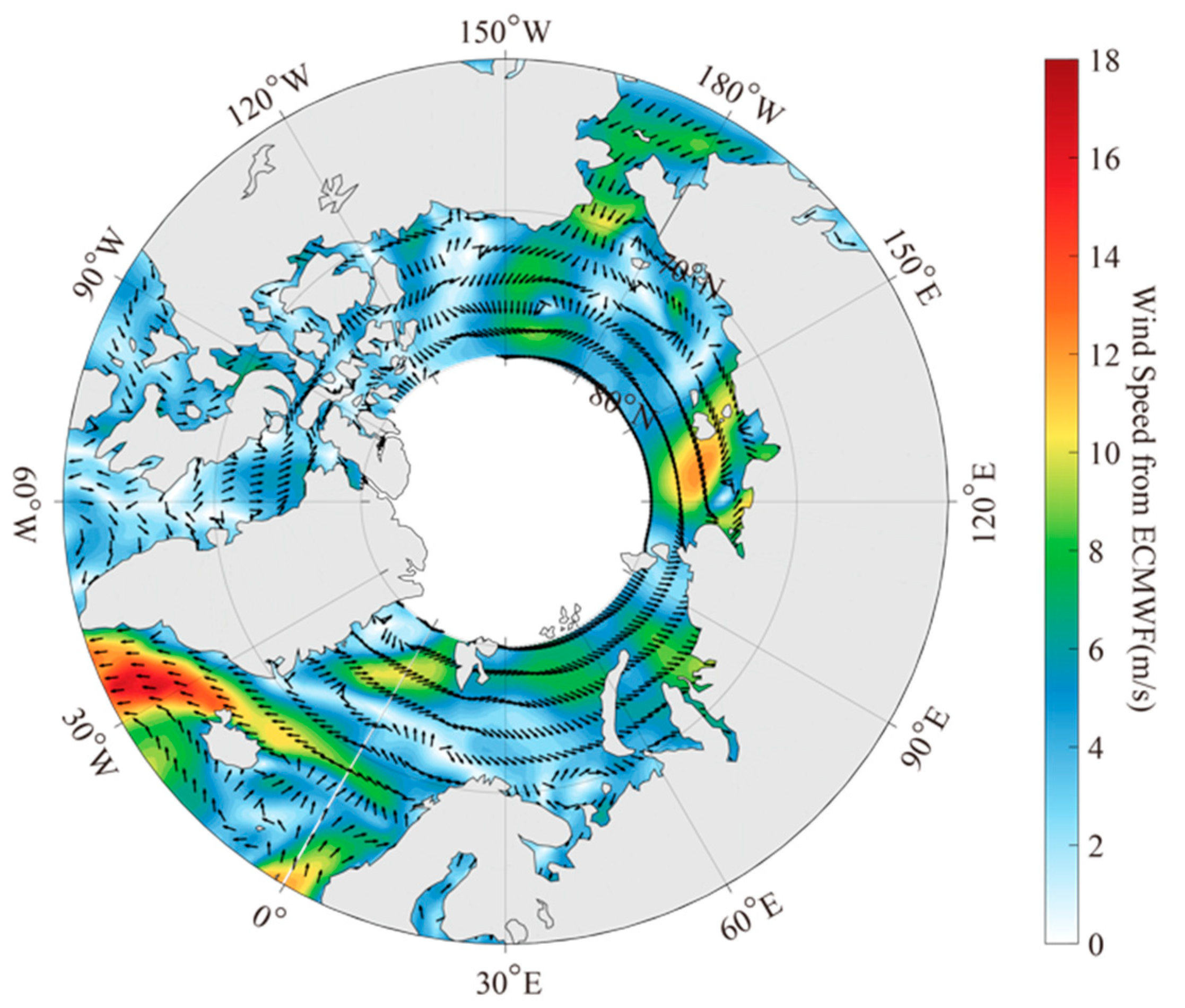
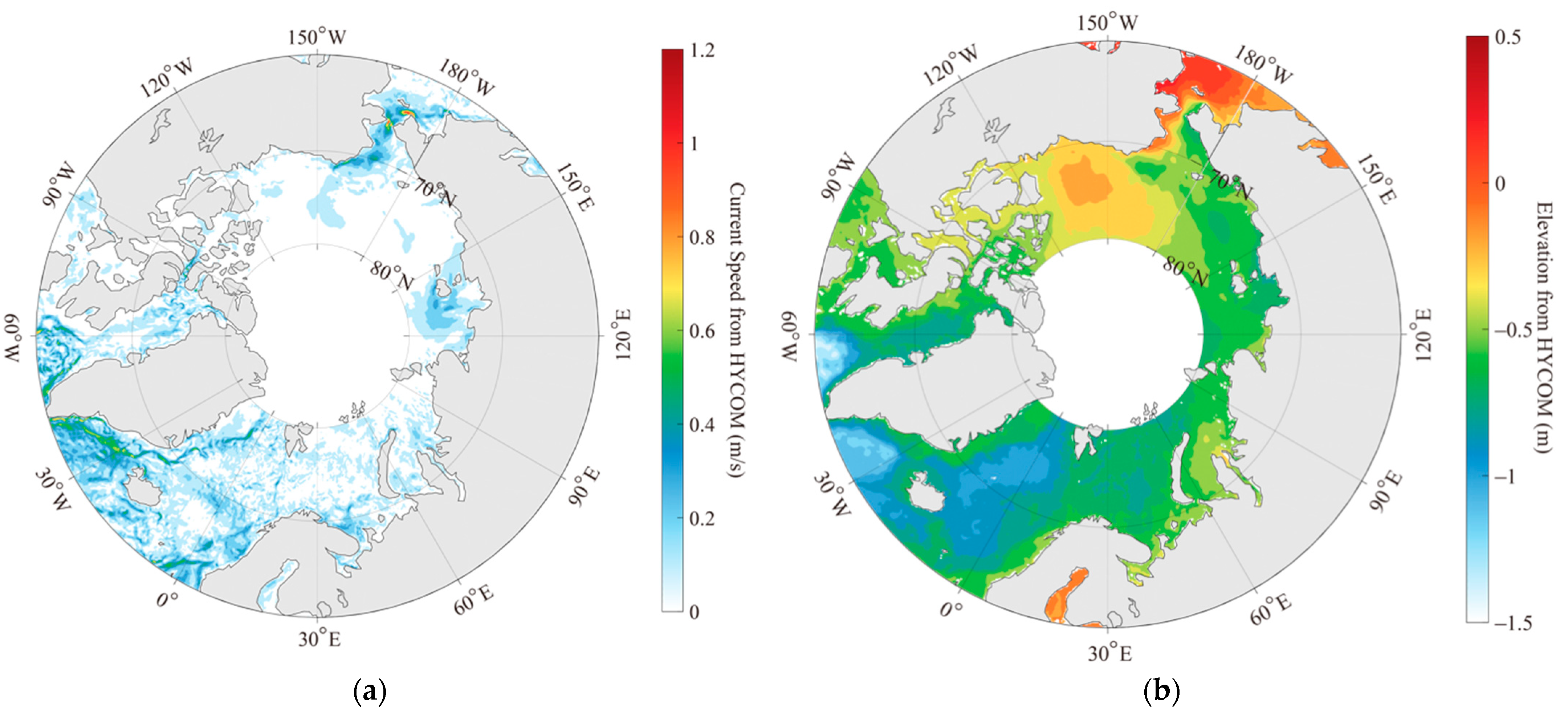
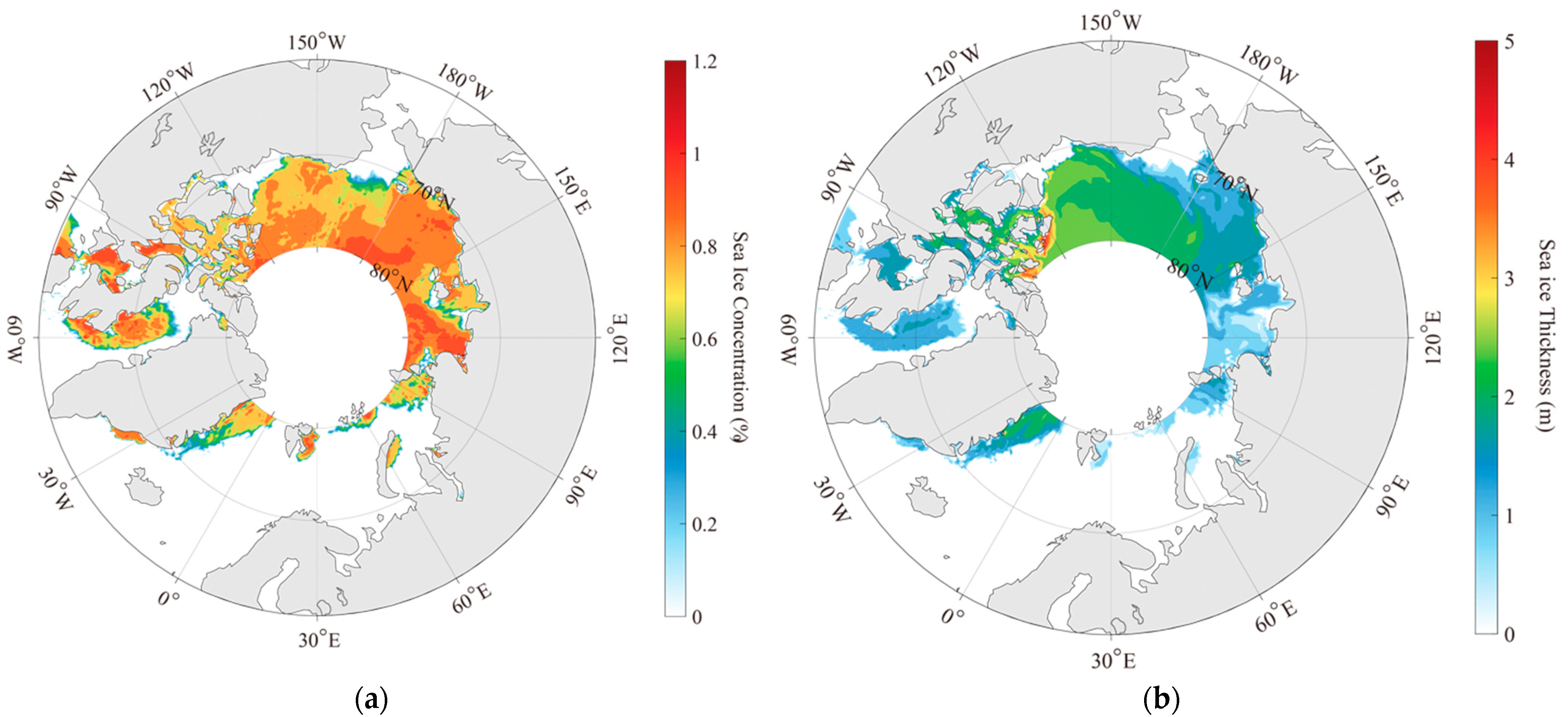


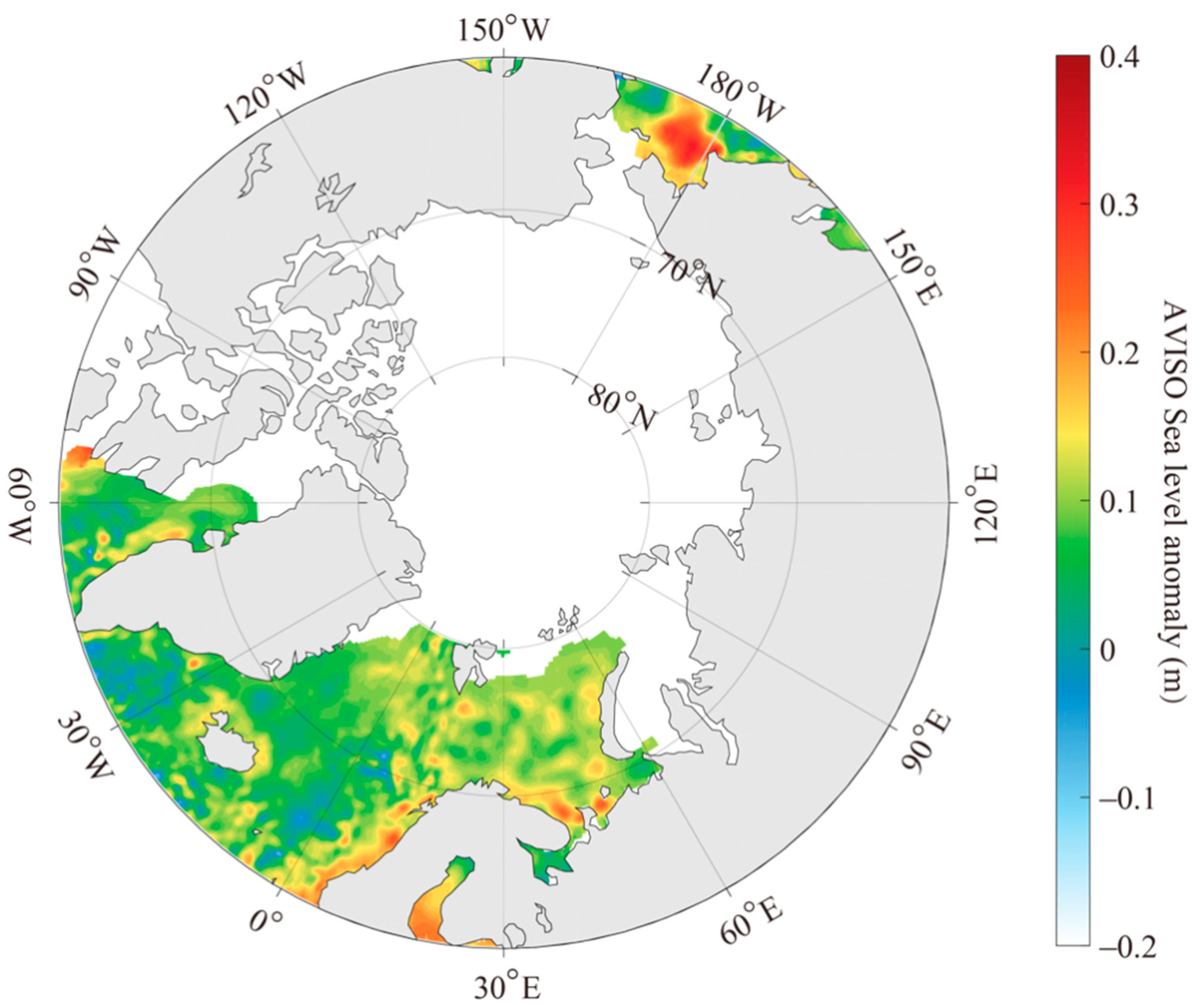
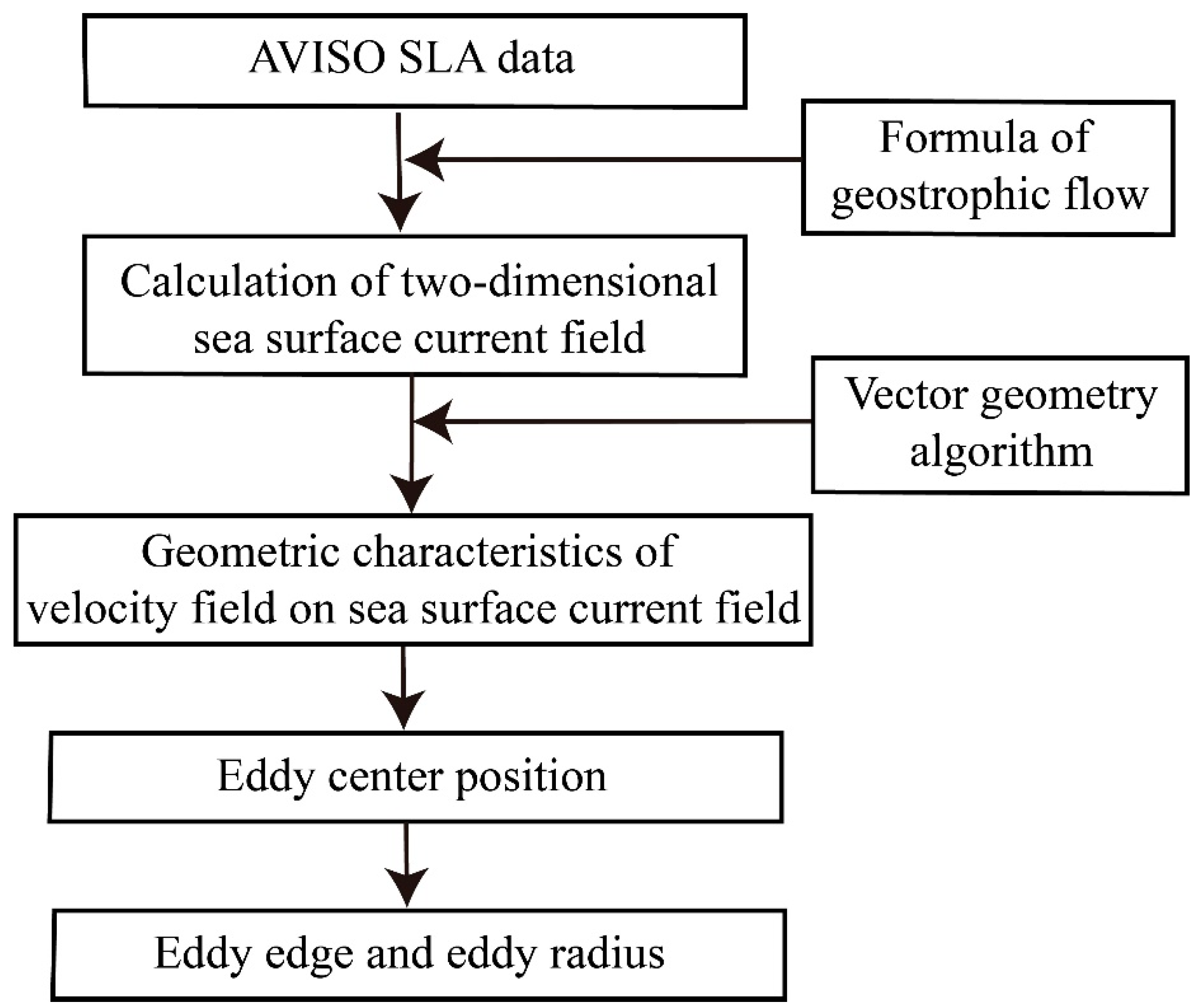
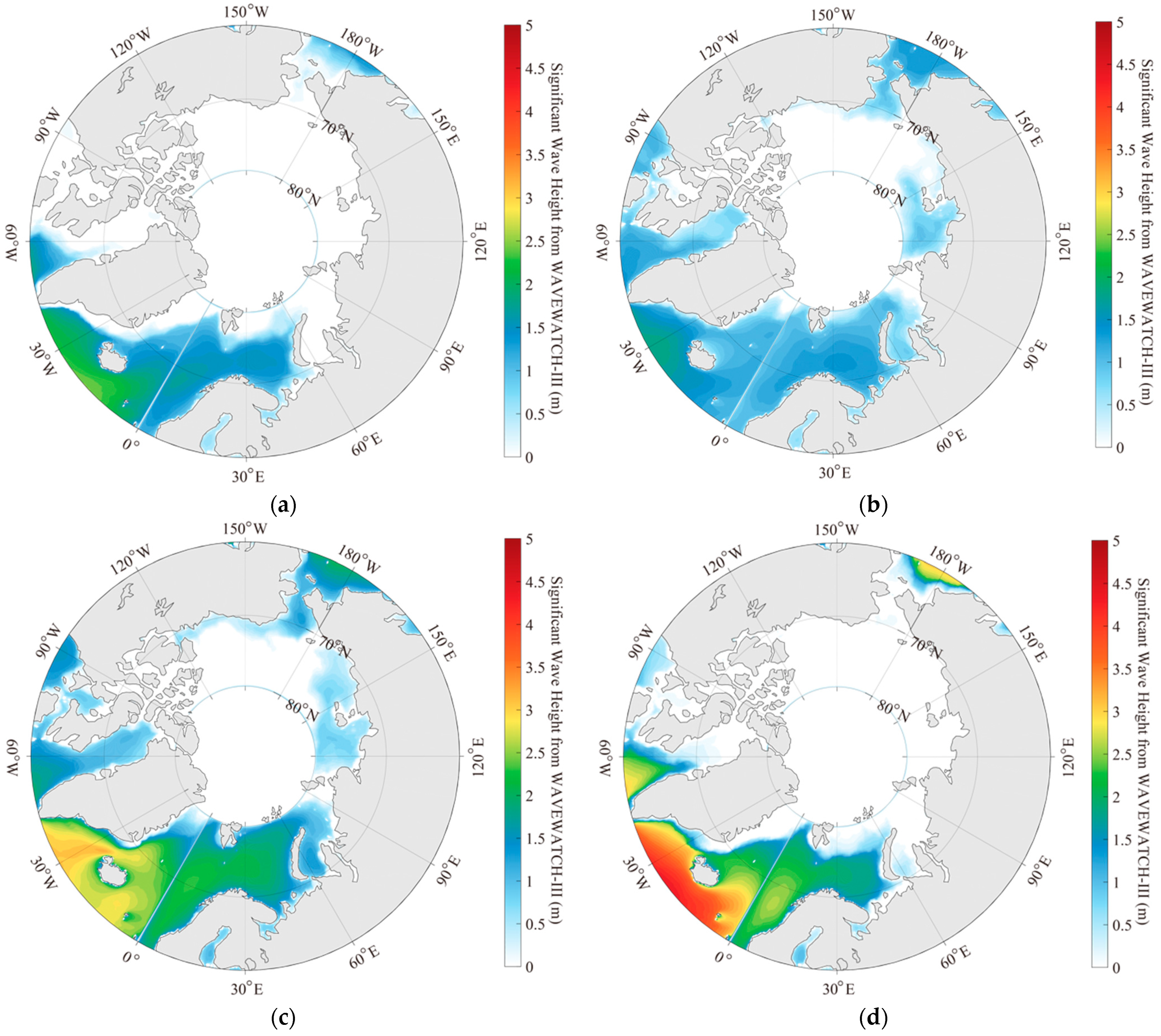
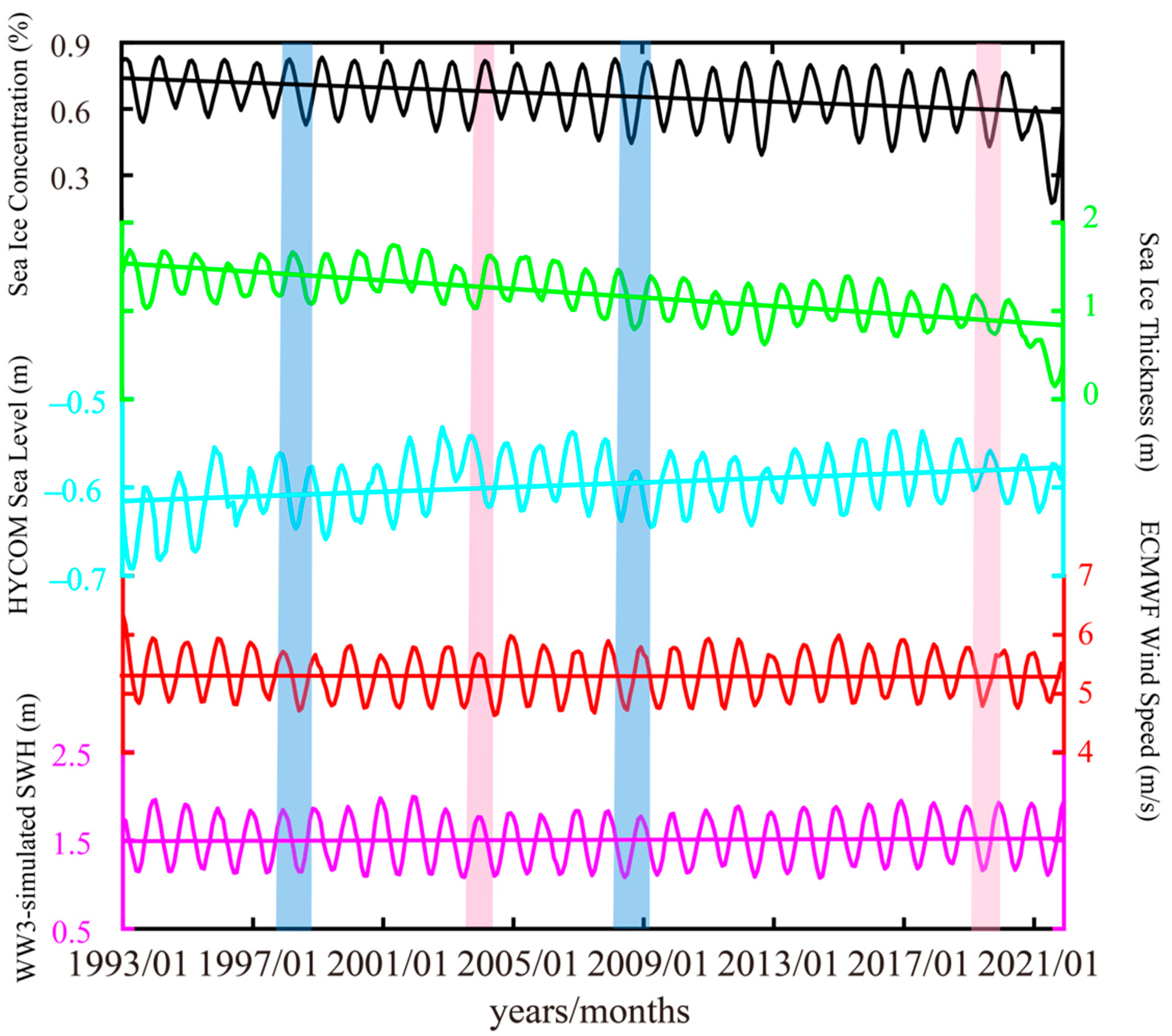


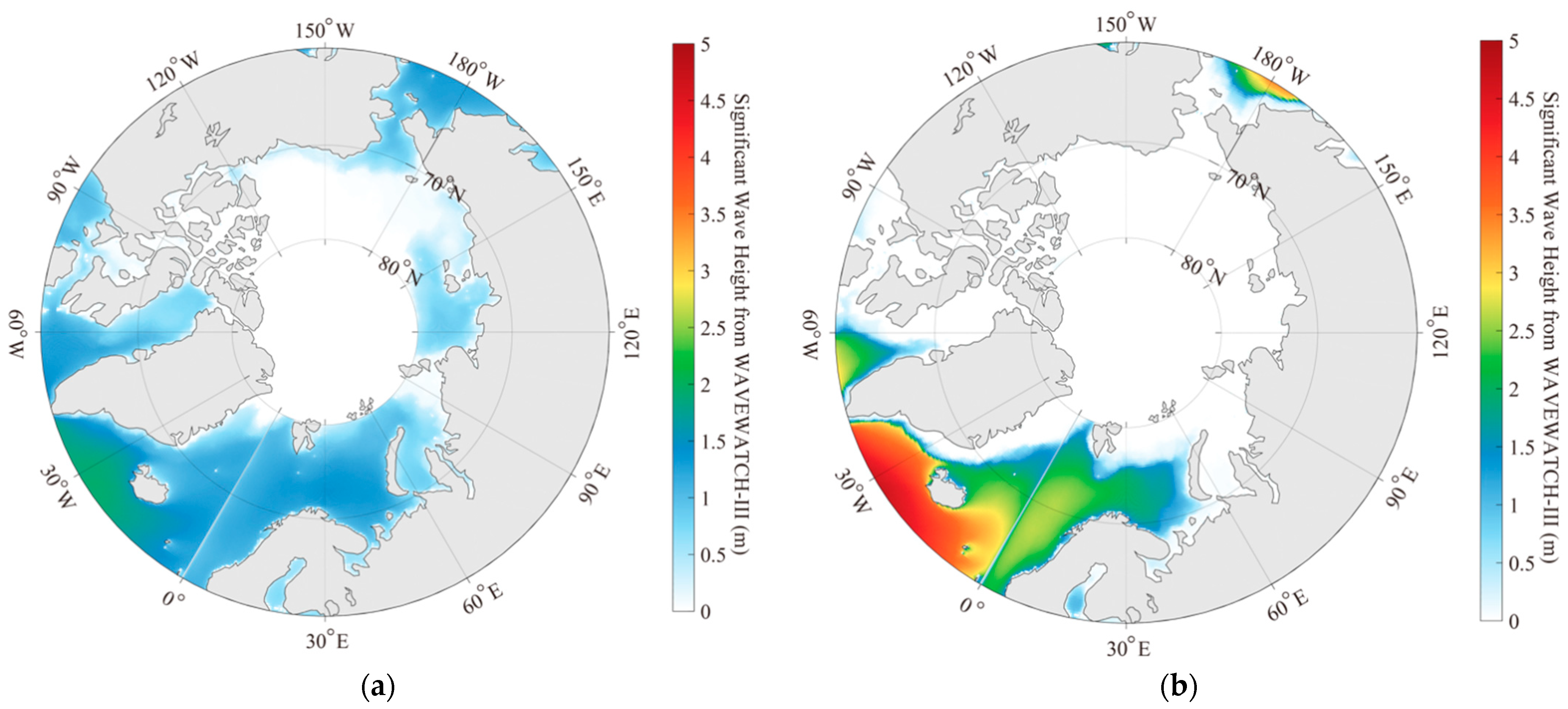

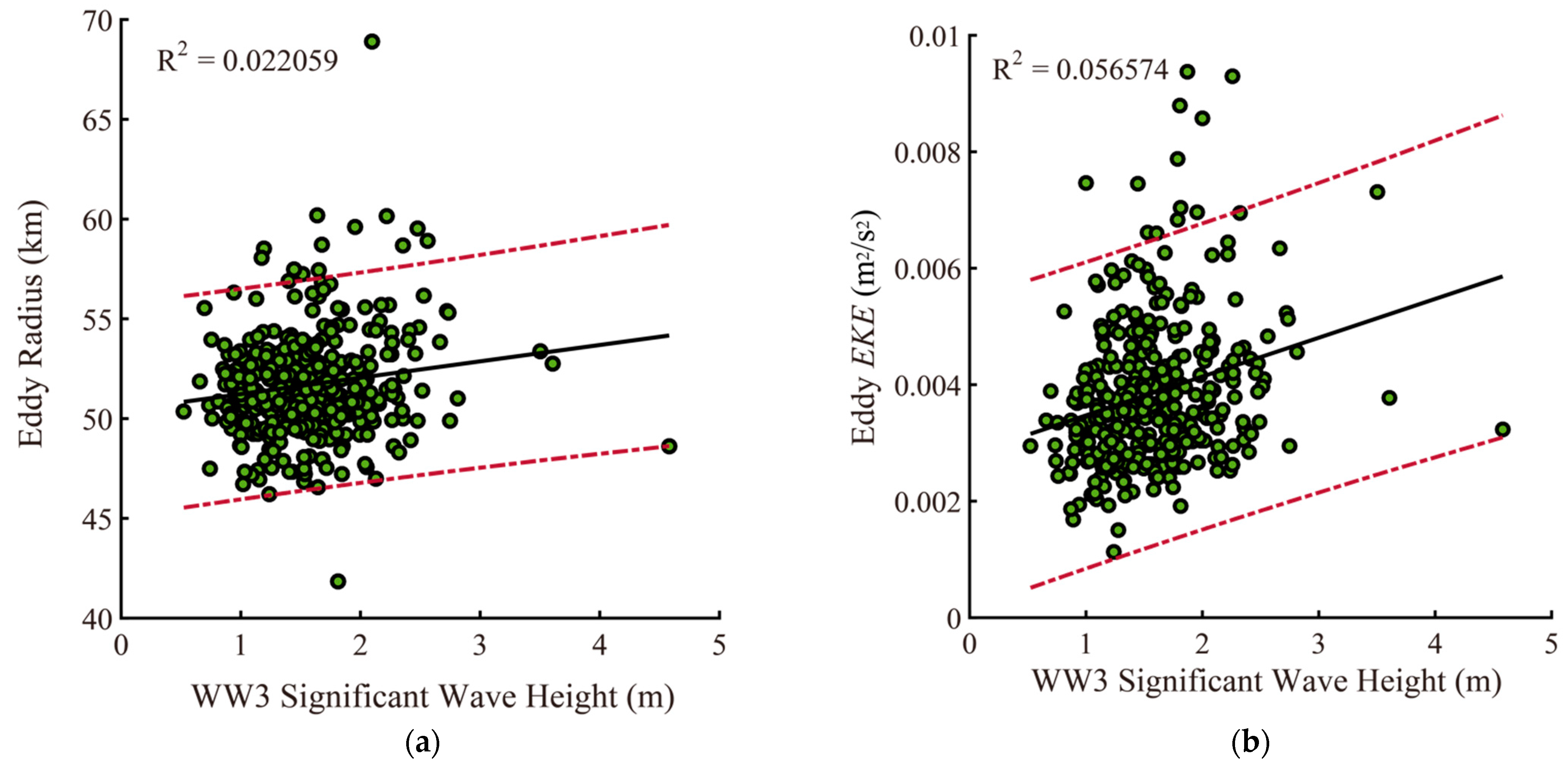
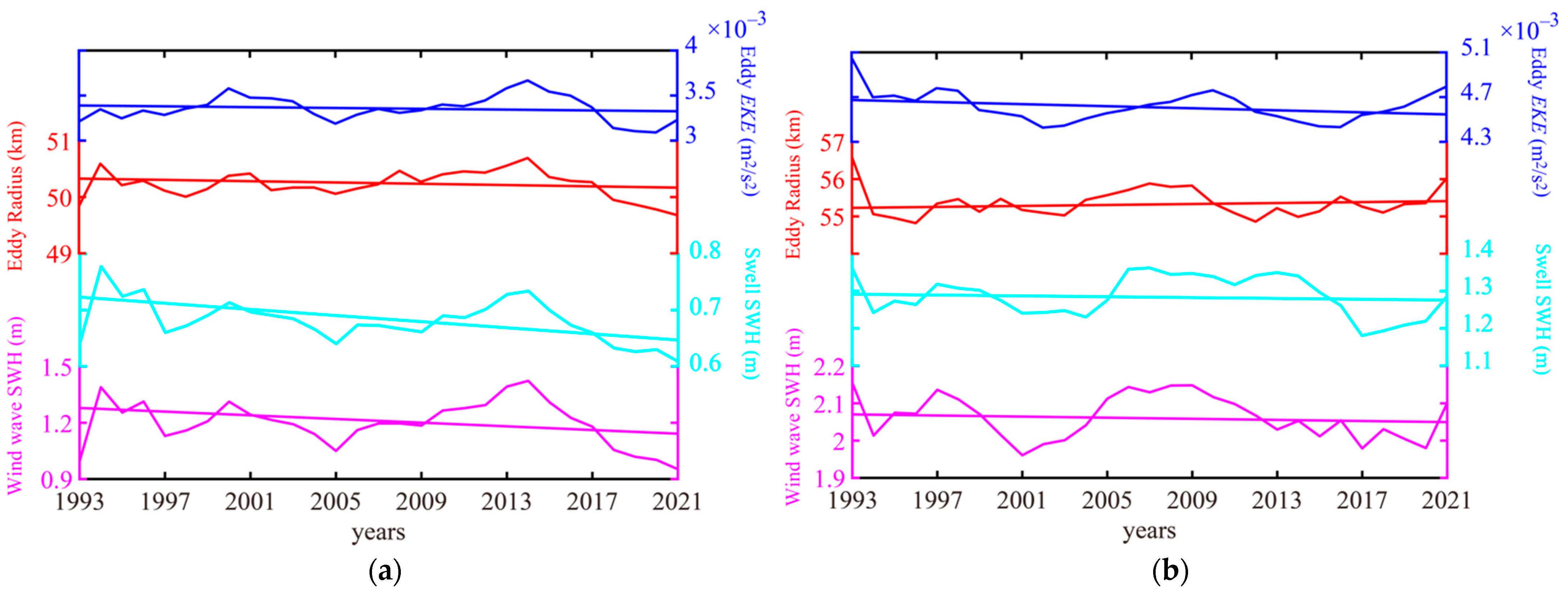
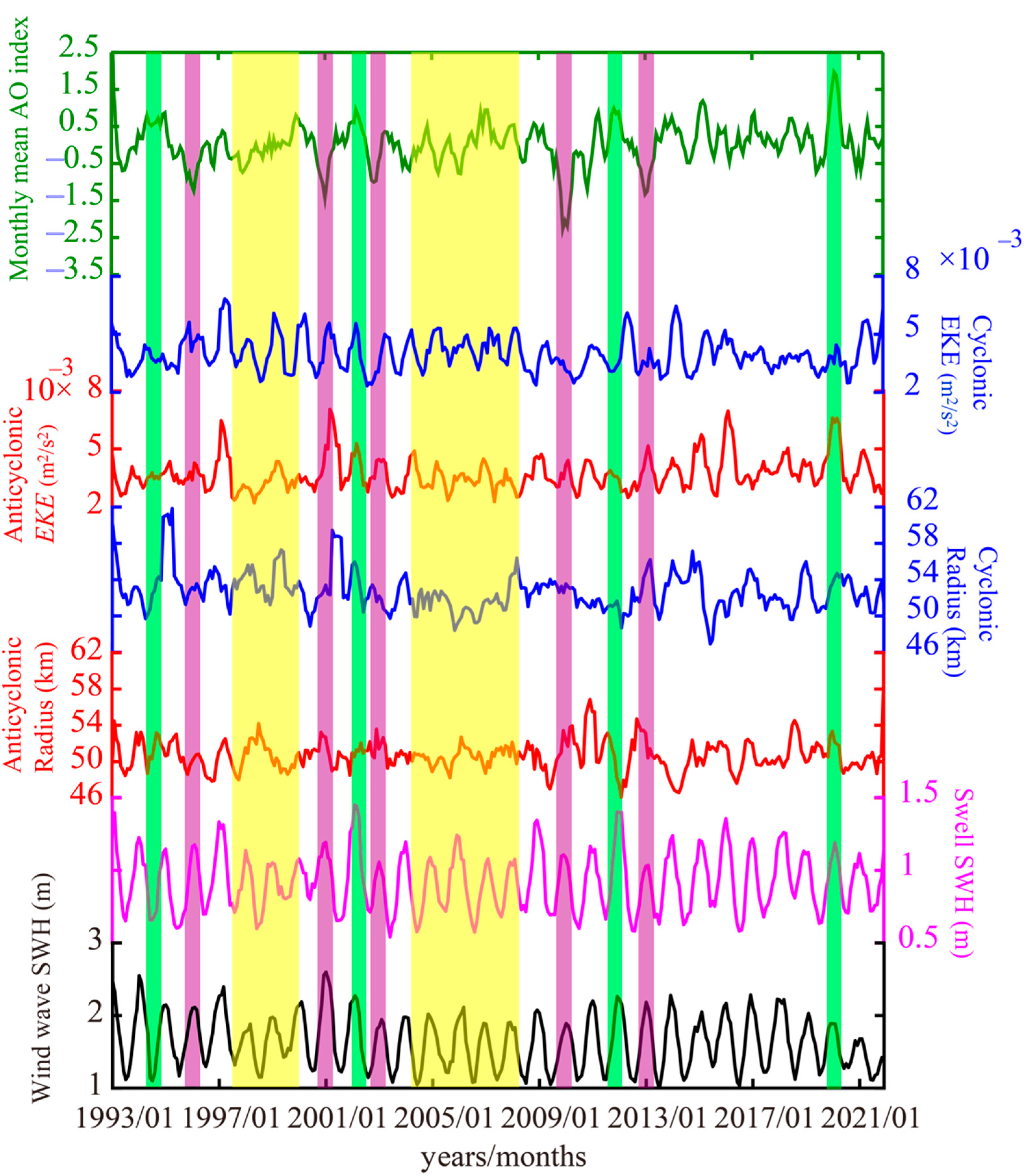
Disclaimer/Publisher’s Note: The statements, opinions and data contained in all publications are solely those of the individual author(s) and contributor(s) and not of MDPI and/or the editor(s). MDPI and/or the editor(s) disclaim responsibility for any injury to people or property resulting from any ideas, methods, instructions or products referred to in the content. |
© 2023 by the authors. Licensee MDPI, Basel, Switzerland. This article is an open access article distributed under the terms and conditions of the Creative Commons Attribution (CC BY) license (https://creativecommons.org/licenses/by/4.0/).
Share and Cite
Xing, G.; Shen, W.; Wei, M.; Li, H.; Shao, W. Wave and Meso-Scale Eddy Climate in the Arctic Ocean. Atmosphere 2023, 14, 911. https://doi.org/10.3390/atmos14060911
Xing G, Shen W, Wei M, Li H, Shao W. Wave and Meso-Scale Eddy Climate in the Arctic Ocean. Atmosphere. 2023; 14(6):911. https://doi.org/10.3390/atmos14060911
Chicago/Turabian StyleXing, Guojing, Wei Shen, Meng Wei, Huan Li, and Weizeng Shao. 2023. "Wave and Meso-Scale Eddy Climate in the Arctic Ocean" Atmosphere 14, no. 6: 911. https://doi.org/10.3390/atmos14060911
APA StyleXing, G., Shen, W., Wei, M., Li, H., & Shao, W. (2023). Wave and Meso-Scale Eddy Climate in the Arctic Ocean. Atmosphere, 14(6), 911. https://doi.org/10.3390/atmos14060911







